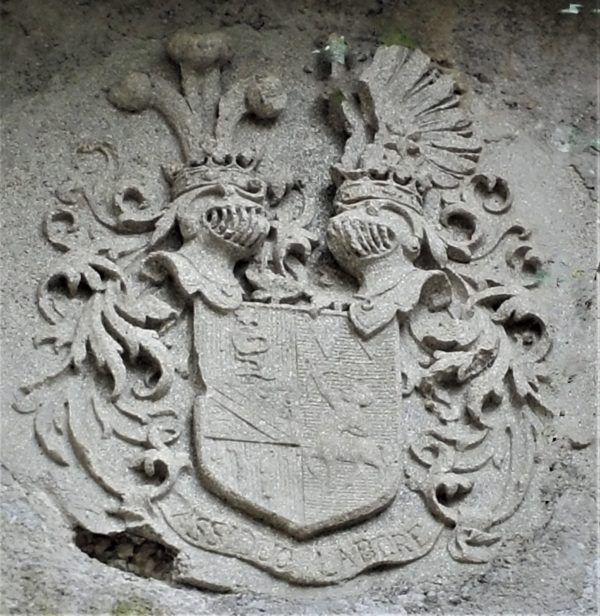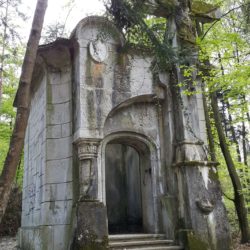
Coat of arms of the Rossmanit-Florstern family in Radvanje
RADVANJE, ROSSMANIT'S TOMB
Location of the coat of arms: façade
Strolling through the forest above Radvanje Manor, one is surprised by the sight of a small, dilapidated structure—a windowless and doorless construction with a rectangular hollow in the ground at its center. One quickly realizes that this is a tomb, and the coat of arms at the entrance further reveals it to be one of nobles. Although ravaged by time, the coat of arms still displays some quite unusual elements discernible to the keen eye—a centaur aiming its arrow at a snake wrapped around a mirror. The coat of arms belonged to the Rossmanit-Florstern family, who owned Radvanje Manor at the turn of the twentieth century.
The common ancestor of the noble Rossmanits was Johann Markus Rossmanit (1779–?), the steward of the Valtice seigniory (Feldsberg) in Bohemia in the service of the Princes Liechtenstein. There, his sons Johann (1812–1859) and Alois (1821–1891) were born, who were both later elevated to nobility. The first ennoblement was granted in 1855 to the elder son Johann as councilor in the imperial-royal representation. His family branch, which remained throughout affiliated exclusively with Austrian territory (Vienna and Salzburg), became extinct in its male line in 1941, with the death of his grandson Adolf.
A few years after 1855, a noble diploma was also issued for Johann’s younger brother Alois. Alois, too, was a councilor in the representation; however, receiving the third class of the Order of the Iron Crown, he could request a higher rank—and was granted knighthood. He completed his knightly title with the predicate Florstern, derived from the first name and maiden name of his Jewish wife, Flora Stern.
On his elevation, Alois requested the same coat of arms as his (already deceased) brother Johann had received before him. However, the final version of Alois’s knightly coat of arms differed slightly from his brother’s: it featured two tournament helmets instead of one, the colors of the ostrich feathers were slightly altered, the centaur was depicted in natural colors rather than in silver, and the ribbon below the escutcheon bore the inscription ASSIDUO LABORE (Constant effort), and another marked difference was the silver star added in the upper dexter field. The star may have symbolized Alois’s only son Alfred, or it may have also alluded to his wife Flora’s maiden name (Stern ‘star’).
Alfred left a profound mark on the southeastern part of Slovenian territory. After starting his career as an attaché in Saint Petersburg, he soon decided to quit diplomacy and devote his life to his lifelong passion: horse breeding and sports. His father therefore purchased for him a castle and an estate in Radvanje near Maribor (called Brandhof). After he put the estate in impeccable order, Alfred embarked on pursuing livestock farming and agriculture as well as apiculture, hop growing, fruit farming, and dairy farming. His life goal became to raise the Standardbred, a sturdy work horse with strong ability in harness racing. An avid horse breeder, he wrote professional articles and was one of the chief organizers of horse races in Maribor and especially in Ljutomer, and he helped organize racing events in Croatia. In Ljutomer, the chief town in Prlekija, his expertise earned him the position of a mentor and supporter of local horse breeders. Finally, he was also the president of many trotting associations (in Maribor, Ljutomer, and Graz), the president of the Styrian livestock farming union, and even the president of the union of all trotting and livestock farming associations of Austria.
After the war, Alfred continued to live in the newly established kingdom for almost a decade. Why he decided to sell Radvanje shortly before his death is not known. The sales contract with Nikola von Jurković from Čalma near Sremska Mitrovica was concluded on August 6th, 1928. Alfred died a few months later, at the end of the same year, in Radvanje. His final resting place is in the family tomb not far from the castle building. In 1970, his remains were transferred to St. Peter’s Cemetery in Graz, leaving the tomb in the heart of the Pohorje forests to the ravages of time.
Sources:
Preinfalk, Miha: Plemiške rodbine na Slovenskem, 19. in 20. stoletje, 3. del: Od Aljančičev do Žolgerjev. Ljubljana: Viharnik, 2017, pp. 174–181.

